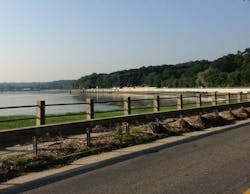Bayville—Oyster Bay, N.Y., rebuilds West Shore Road after Hurricane Sandy
On Oct. 29, 2012, the storm surge from Hurricane Sandy hit Long Island with a vengeance causing major beach erosion along the island’s south and north shores. One of the regions that received a great amount of damage was the Bayville–Oyster Bay area. West Shore Road, which is the main route between Oyster Bay, Bayville and the outlying Centre Island, was almost completely destroyed.
The immense tidal surges, high winds and heavy rains caused approximately 30 years of erosion damage in only three days. The damage closed down West Shore Road, causing a disruption to the local economies and livelihoods of the people in these communities. The road needed to be fixed—both quickly and soundly.
The key to the reconstruction of the road was the replacement of the retaining wall that held up the road and protected it from the harbor tides. The chosen engineering firm, Lockwood, Kessler & Bartlett Inc., chose Stone Strong Systems as the retaining wall solution for the road reconstruction. Unlike a traditional poured-in-place wall, the selected retaining wall system is precast, eliminating the need for long forming and curing times before backfilling. It is a quicker method that doesn’t require leaving open excavations for extended periods of time. By using a precast concrete solution, it was estimated that the contractor could install approximately 750 sq ft of retaining wall per day, with the ability to backfill immediately after installation. In addition to the speed and convenience of the precast wall, it also features a drainage system, which was a major advantage given the close proximity to harbor tides.
Construction began in December 2012 with a goal of completion by July 2013. A variety of preliminary work was required prior to construction of the retaining wall, including utility installation, construction of a temporary cofferdam to protect the construction zone from the harbor waters and dewatering the area between the cofferdam and the road. In March 2013, LHV Precast Inc. began delivering retaining wall blocks to the site. The design of the retaining-wall system utilized 24 sq ft, 86-in. extended blocks and 24 sq ft, 6-in. mass extenders. Because of the potential for beach erosion and possible undermining, a 60-in. minimum bury was required.
Despite some lost time coordinating utility repairs, final paving was completed on July 1, 2013, in time for the national Fourth of July celebration. Even under difficult conditions, the project was completed on time, allowing the surrounding communities to recover in time for the important summer season.
